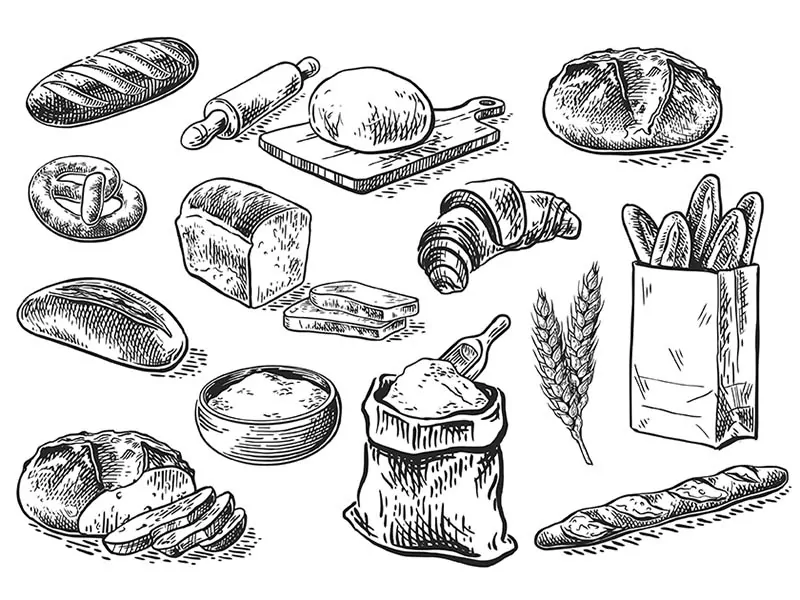
You may want to know about different types of dough when you first make some pastry or baked items like cake or cupcakes. They are actually not that hard if you know how to make them. You can learn to make them yourself by reading the simple instructions.
There are more types of dough than you have ever imagine. There are a lot of specialized types that are designed for each type of bread or pastry. Let’s explore them all with the ultimate dough list that you should totally know!
Let’s Learn About The History Of Dough
No one may know exactly when the dough appeared in the past. But there is a lot of evidence showing that people used flour in their meals 30,000 years ago in the prehistoric period.
Back then, the dough mixture was simply flour with water that was created unintentionally. People flatten and cook the mixture on hot stones for a meal. 20,000 years later, they domesticated and grew wheat, thereby creating the new version of dough.
Then came the discovery of yeast. People started to use yeast in the dough for rising, thereby making more variations of dough that are still in use today.
The Couple Of Classic Dough Textures
Before reaching the list of dough, you should definitely know about these two basic texture types of dough! Different ingredients and methods will result in different textures at the end, and the following two are the most typical ones you will likely get.
Mealy Dough
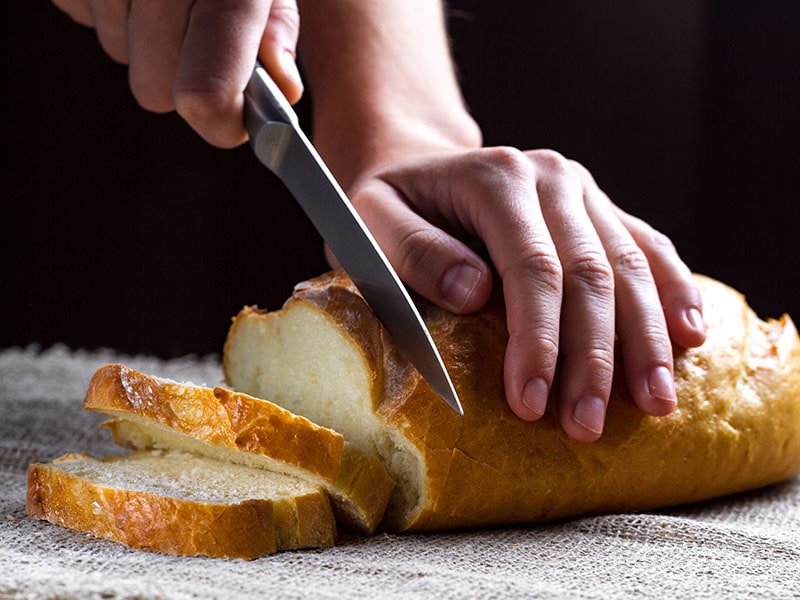
The mealy texture will be more compact, denser, and crispier than the other one. The baker will incorporate the fat evenly into the mixture to get this texture. This process will last for a long time until the mixture looks somehow like cornmeal.
You should know that mealy dough doesn’t absorb much water. After you bake this dough, it will turn into a tender shortcrust pastry that does not get soggy over time. This dough will get along really well with liquid fillings. It can also be a great base for fruit pies.
Flaky Dough
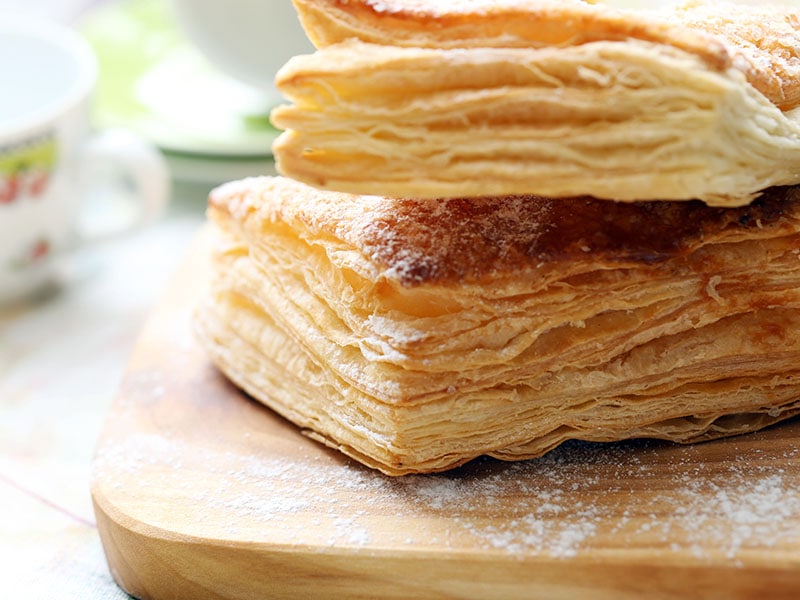
If you make the dough by mixing the fat with flour for a short time, you will get a layered, flaky texture in the end. The baked mixture will include large chunks of fat, which are unevenly distributed inside.
The final result may vary due to the amount of fat used and the temperature while it is baking. You may meet the flaky dough in making top crusts and bottom crusts for pastries with fillings in liquid form like custard.
Laminated Dough Vs. Non-Laminated Dough
If you have ever made pastry dough, you may know that there are two basic types of dough that are divided based on the number of layers that the final result includes. They are laminate dough and non-laminated dough. Let’s find out how they differ from each other!
The obvious similarities between these two dough categories are that they can be both leavened or unleavened dough, and they may both consist of butter or fat in the mixture.
Laminated dough will be folded and refolded many times to create layers. Before that, the baker will cover the dough with butter or fat like oil. In this process, the gluten will start to develop. The examples for this dough type are puff pastry dough and phyllo dough.
The non-laminated dough will not include the folding process. Therefore, the final product doesn’t contain layers like the other one. It may still have butter or fat in the dough mixture. The most common non-laminated doughs are pie dough, choux pastry dough, and brioche.
10 Spectacular Types Of Unleavened Dough You Should Learn
Unleavened dough types will not contain any leavening agent. Bakers use them for baked items that don’t have to rise but consist of a thin and flaky texture. Some of them may be a bit complicated to make and require more proper skills. Let’s learn more about them!
1. Pasta Dough
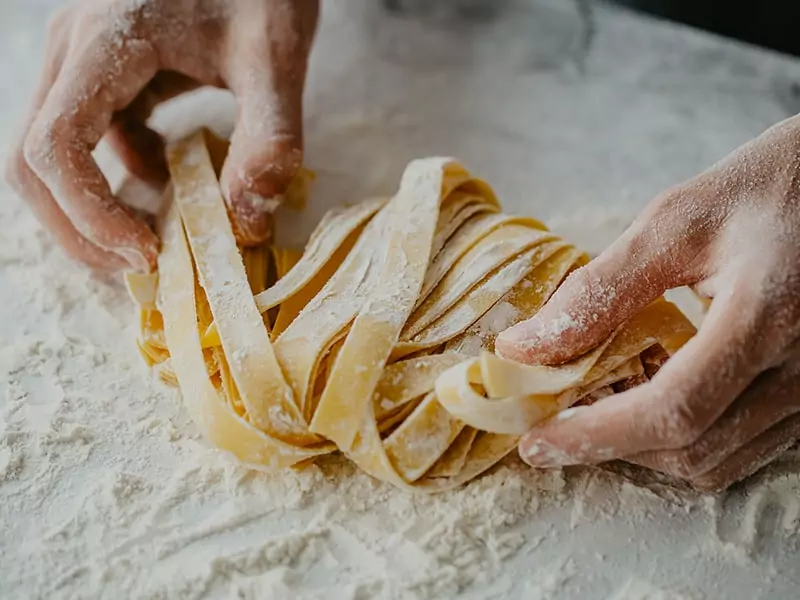
Pasta is one of the most popular starch foods in the world! It is made from a specific type of dough: pasta dough. This is considered a difficult dough to make because you must do a lot of kneading steps.
Pasta dough contains basic ingredients like eggs, wheat, and salt. Sometimes, it may include bean flour, legume flour, or rice flour. These flour types will bring a new and distinctive taste to the pasta dough.
The maker will roll the dough thin and cut it into small pieces, then continue to roll them into Fettuccine or Ravioli shapes and drop them into boiling water at the end.
After that, you can serve them with your favorite variety of pasta sauce. You may also find many variations of pasta dough in different cuisines like German Spaetzle or Chinese dumplings.
2. Pie Dough
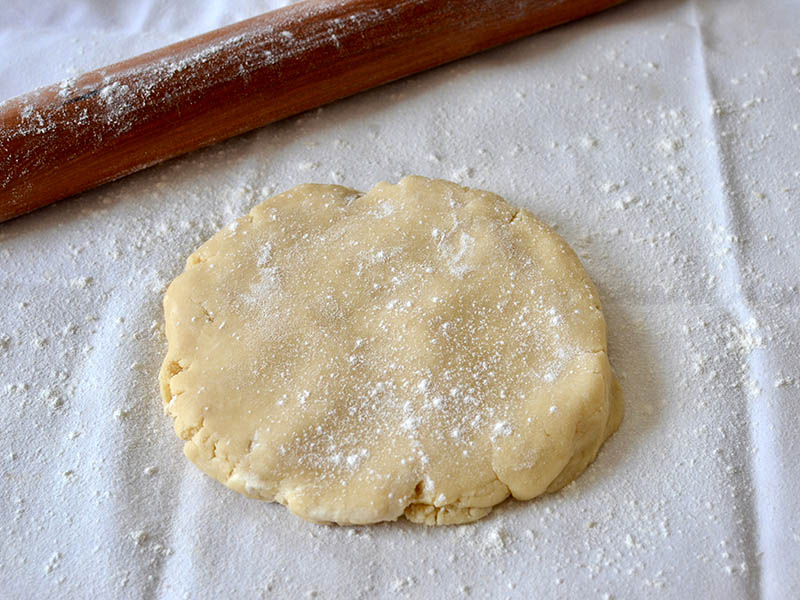
Pie dough includes basic ingredients such as all-purpose flour, salt, fat, and water. The fat can be shortening, butter, lard, or even oil.
When making pie dough, all of the ingredients should be kept as cold as possible. A successful pie will depend mostly on how cold they are, how even the fat distribution is, and how much developed gluten there is.
Let me tell you a small secret to solidifying the butter for the flakiest texture. After flattening the dough from a ball shape to a disc shape, wrap it with plastic wrap and chill it for about half an hour. Then, roll out your dough as usual.
Some advanced versions of pie dough contain baking soda, vinegar, or other flavoring items, such as lemon juice, cider, sugar, or eggs. The gorgeous golden-brown final product may be mealy or flaky with a tender texture.
This professional baker will show you how to make pie dough from scratch!
3. Pate Brisee
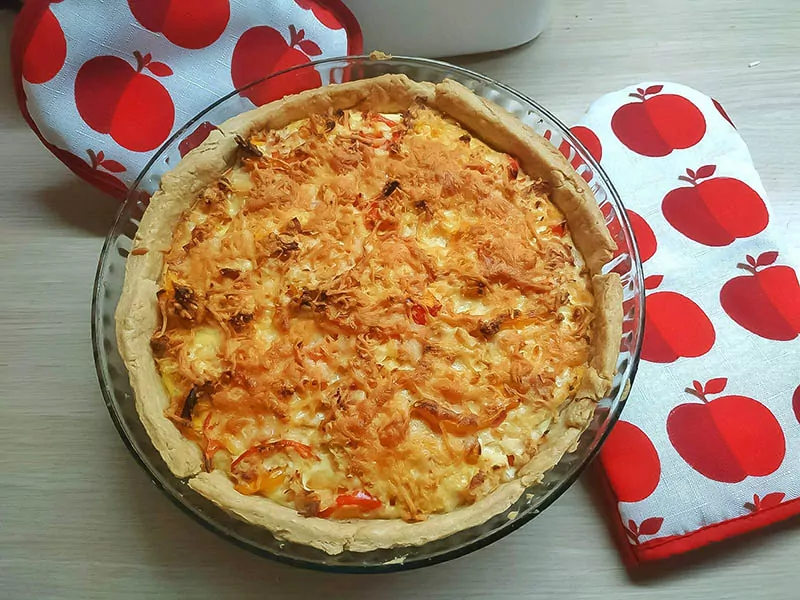
People consider pate brisee one of the most well-known mealy pie doughs that usually appear in desserts like fluted eggs. This type of dough contains water, butter/fat, and flour in a ratio of 1:2:3. It doesn’t have sugar, which differs from many other types.
You can always apply pate brisee when making fillings under liquid form. It often shows up in custard filling with other ingredients like egg, vanilla extract, lemon juice, and salt.
4. Pate Sucree
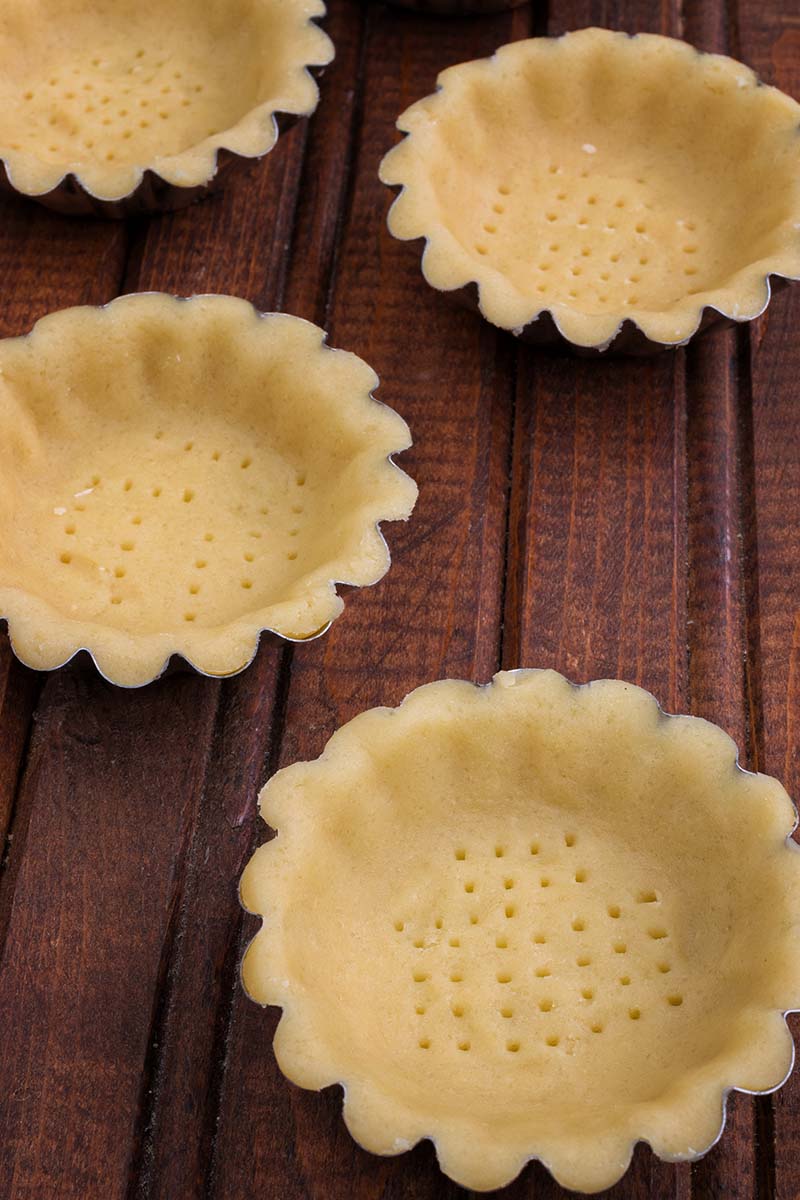
Pate sucree, or the short dough, may sound like a typical pate typefrom France. It also includes water, fat, and flour in a 1:2:3 ratio like pate brisee. The only difference is that there’s a lot of sugar as a vital flavoring item in pate sucree, while pate brisee is sugar-free.
This dough type is also called sugar dough with a high amount of sugar, so it tastes really sweet and may remind you of cookies. You may apply this dough to make cookies and tarts for a delectable dessert.
Want to make this sweet pate sucree? Here’s basically how!
5. Pate Sablee (Sablee Dough)
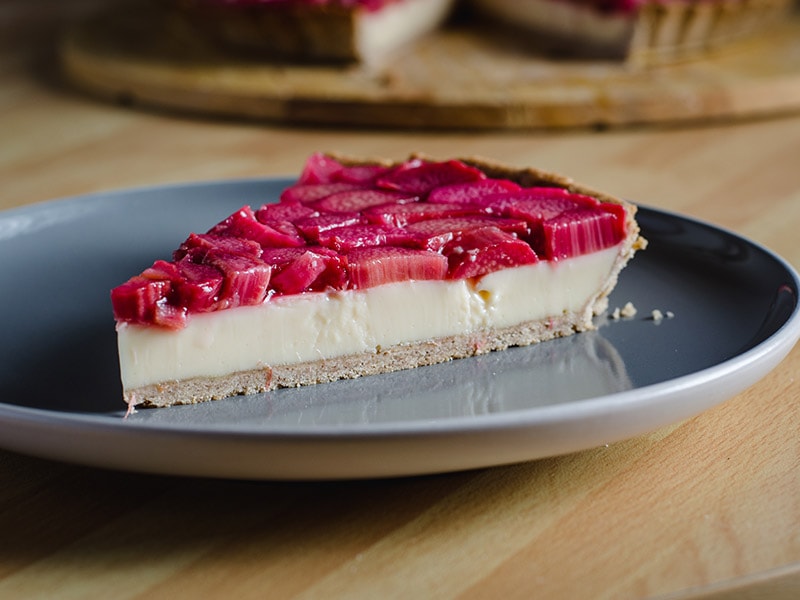
You may find pate sablee under the name “sandy dough,” which relates to their cookie-like appearance. First, the baker will cream fat with sugar to make this dough. After that, they will add eggs and then flour to complete the mixture.
The blind baking technique will be applied to bake the crust, either whole or partially baked. The traditional recipe usually calls for 15% sugar and 15% ground almond. Nowadays, some new pate sablee recipes may also require egg yolks to get a more tender crust.
Do you know that pate sablee is the regular dough for making tarts – a famous dessert from France? People of all ages love to have this world-famous dessert any time of the day.
Many chefs use pate sablee to make delicious desserts with a pie crust. You can also bake the sablee dough without any ingredient addition. The outcome will become the best cookies ever for your children!
6. Puff Pastry Dough
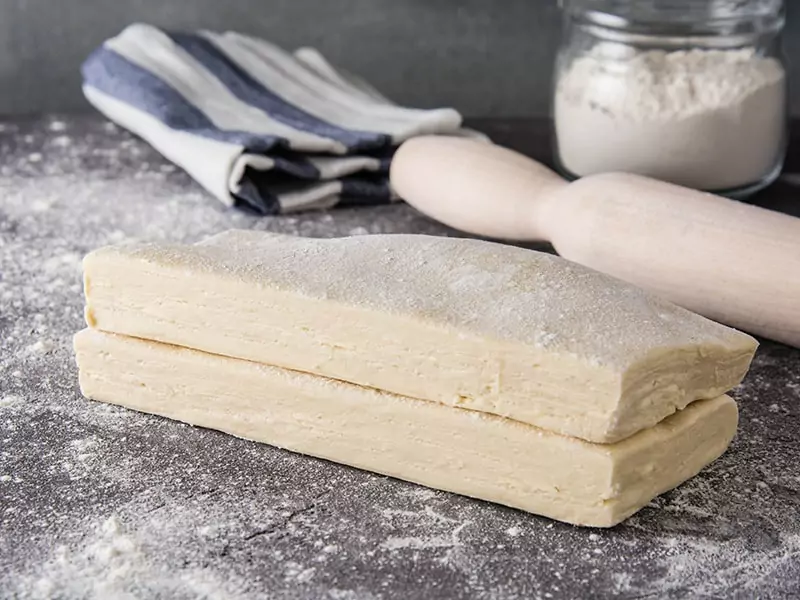
Puff pastry dough is from France and maybe a bit more complicated to make than other types of dough in this list. First, the baker will roll the dough with butter, then turn, roll and fold the mixture repeatedly. After that, they’ll let it rest for the butter to evenly distribute.
The butter will melt and divide the dough into distinctive layers when you bake the prepared mixture. Therefore, people also call the puff pastry made from this dough “leaf pastry.” It will be super buttery with a flaky, delicate, and crispy crust.
You may also want to apply puff pastry dough to make napoleons or desserts calling for puff pastry! Though time-consuming, it is always the type of dough that chefs usually use to make pastries.
7. Phyllo Dough (Filo Pastry)
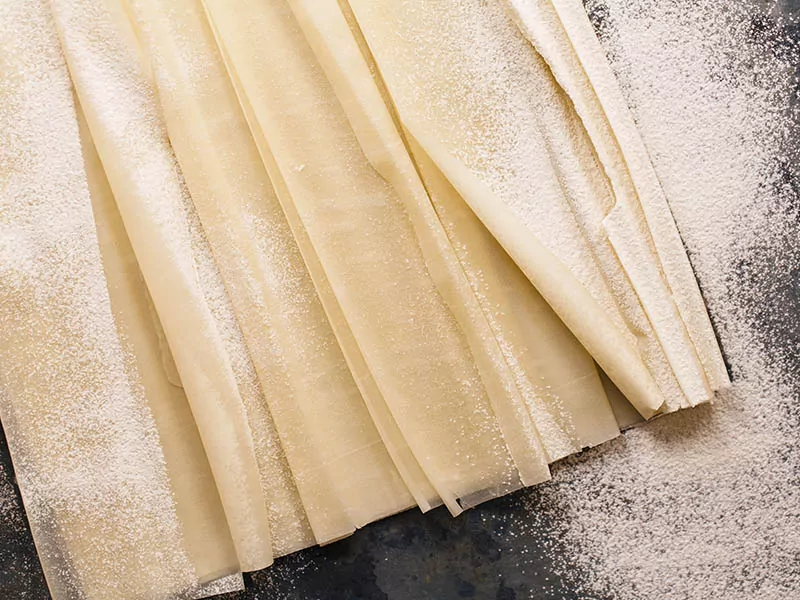
“Phyllo” is a Greek word that means “lea”, describing the super thin and light texture of this dough. It is famous for making pastries and crispy pie crust for meat pies. The making process will include stretching the dough into thin and transparent pieces.
Phyllo dough resembles puff pastry, but the dough mixture does not contain any butter. People will add butter or fat later to separate the layers. They will layer many phyllo sheets and brush each of them with butter or oil before bringing them to the oven.
The above process results in a thin and light texture of phyllo dough! If you want your dough to be thicker, consider adding veggie fat while making it. This will surely create a heavier texture for your final product.
You should use phyllo dough to make some delectable dessert dishes in Middle Eastern cuisine. Baklava is one of the most popular desserts using this type of dough.
It’s never been easier to make phyllo dough with this instruction!
8. Choux Pastry Dough
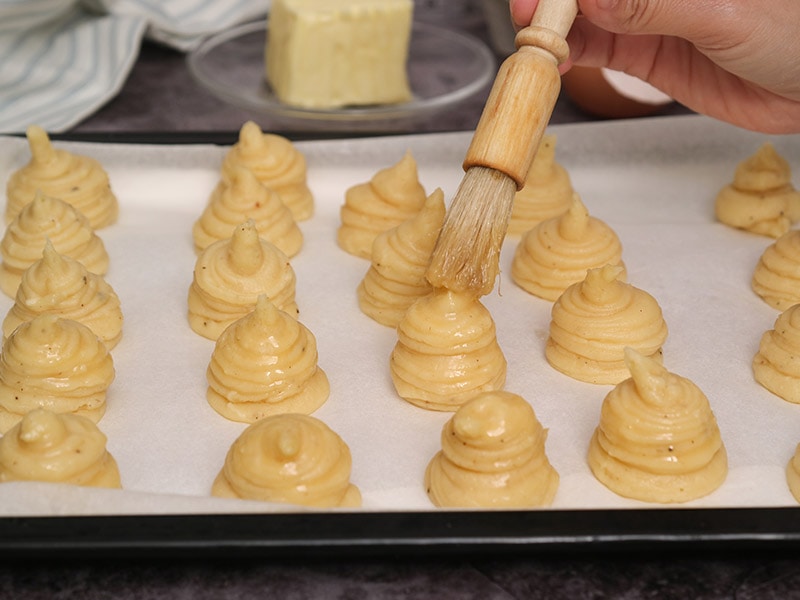
Choux pastry dough, also called pâte à choux, was invented in the 1500s (specifically in 1540) to celebrate the wedding of King Henry II and Catherine de Medici. It includes basic ingredients such as flour, butter, water, milk, and eggs.
The maker will beat the choux pastry mixture together on the stovetop until it becomes thick. It doesn’t use a leavener like yeast in the mixture, so the moisture inside helps steam the dough. This process will create a puff pastry with a crispy, perfect golden outside.
The pastries made of this type of dough may have many filling choices inside, which can be custard, whipped cream, or jelly. Chefs may use choux pastry dough to make Paris-Brest, éclairs, croquembouche, and profiteroles.
9. Kourou Dough
Kourou dough is actually a type of rich dough that uses eggs and butter. Some recipes also require milk and yogurt in the mixture. This type of dough doesn’t require a lot of fat like other puff pastries. You only have to add a little bit of oil to the mold.
The bread from Kourou dough will be crispy and a bit dry, but its flavor is super tasty and flavorful. Chefs love to use this dough type to make quiches, turnover, pies, and tarts.
10. Tortilla Dough
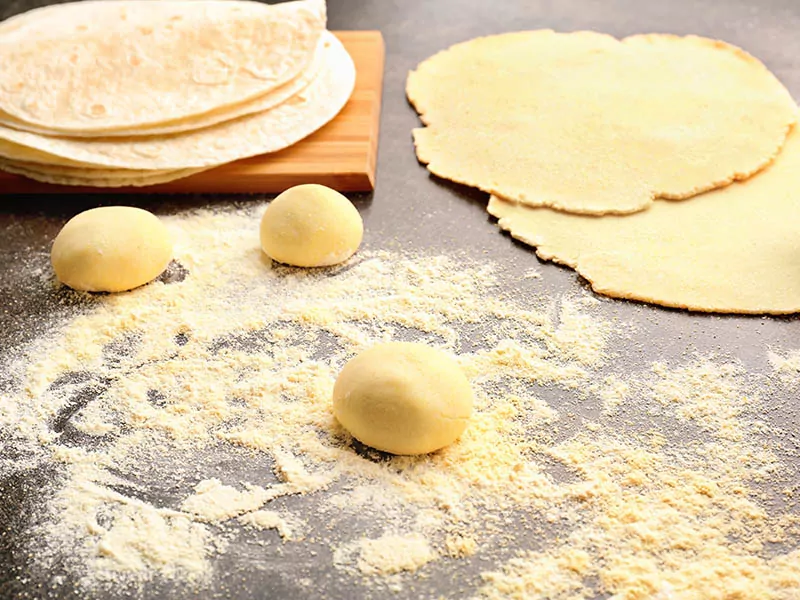
If you are interested in Mexican cuisine, you may know about tortilla dough! The typical type of dough includes unleavened cornmeal, lard, and water that chefs use to create tortillas. They will roll and shape the mixture into disks, then fry the pieces in a hot, dry pan.
At least, that is what classic corn tortillas are made. When it comes to flour tortillas, their dough usually consists of all-purpose flour, salt, lard, and water. Baking powder may occasionally be added to it.
6 Basic Types Of Leavened Dough Every Baker Must Know
Leavened doughs are ones including yeast or other leaveners like baking soda and baking powder. These dough types will require some time for fermentation; therefore, they may be a bit more time-consuming than unleavened dough. Let’s dive into them!
11. Bread Dough
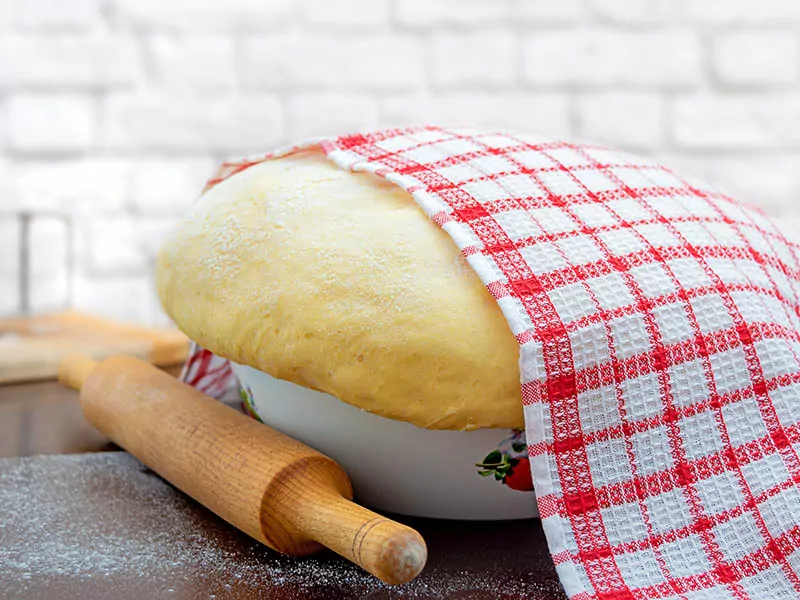
Bread dough is a typical yeast-based dough containing wheat, yeast, and water. Sometimes, the chef may use baking soda to replace yeast in the mixture as a leavener. That version, including baking soda, is usually called soda bread.
You should knead bread dough carefully and repeatedly to develop gluten. If you do it correctly, the final product will be elastic, firm, and easy to rise in the baking process. This is the most basic type of dough that every beginner should learn at first!
Learn to make this basic bread dough with simple instructions!
12. Sourdough
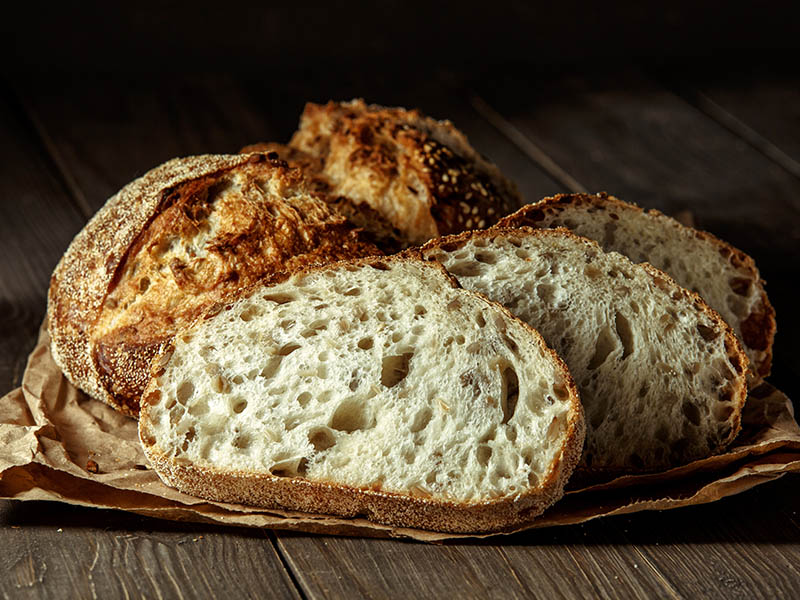
People consider sourdough one of the oldest bread types. It probably originated in ancient Egypt and the Fertile Crescent (a crescent-shaped region spanning over many Middle Eastern countries) thousands of years ago.
The sourdough mixture includes essential ingredients like flour, water, and salt. The dough contains bacteria developing naturally with yeast. The bacteria having lactic acid is the reason for the sour flavor of sour bread.
The sour bread from sourdough consists of a soft layer outside and a chewy inside with large air bubbles. This type of bread differs from many other types because it doesn’t have yeast, milk, sweetener, or fat. Bread made from sourdough may last for a very long time.
13. Brioche Dough
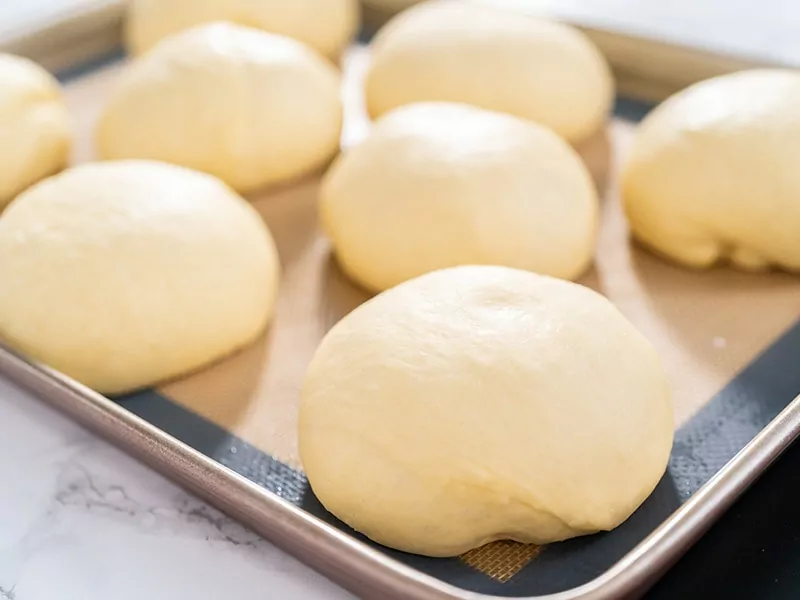
Brioche dough is a yeast-based type of dough that bakers often use to make many pastries, especially brioche pastries or bread. The final result will consist of a creamy and tender consistency and a pleasantly sweet flavor.
Brioche dough includes eggs, flour, butter, milk/water/cream, salt, and leavening agents like yeast or sourdough. It doesn’t bring crispiness or crunchiness to the final products. You can either roll the dough mixture into balls or keep it in the classic loaf shape.
14. Pizza Dough (Pizza Crust)
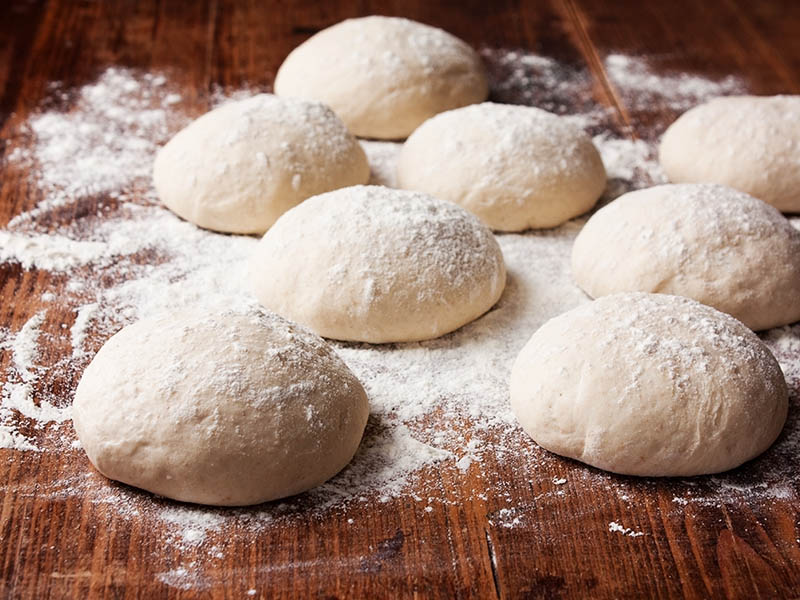
Learn to make the pizza dough so that you can make a pizza from scratch by yourself! People usually include five basic ingredients in pizza dough: flour, yeast, salt, water, and oil. I’m sure that this type of dough is super easy to make, even for beginners!
The baker will use a distinctive cold fermentation process to make pizza dough, which means they will put the dough in the fridge. This process will slow down the carbon dioxide from the yeast. Therefore, the outcome will have a perfect airy texture and pleasant flavors.
Making pizza dough is easier than you’ve ever imagined!
15. Croissant Dough
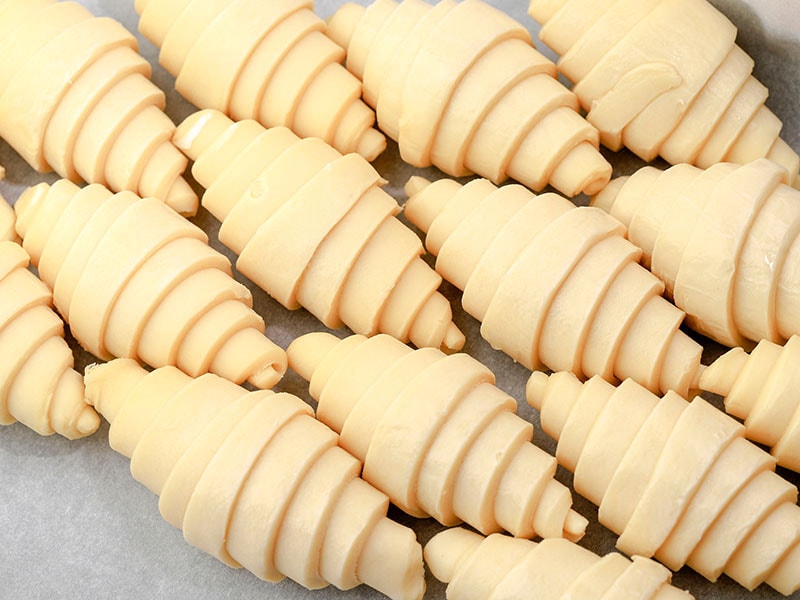
You may confuse croissant dough with puff pastry dough because their appearance is somehow alike. However, the croissant dough contains yeast to create more air bubbles and fluffiness.
To make the dough, bakers rigorously mix butter, flour, yeast, and cold milk together. The dough should stay cold during the entire process. Then, they will get the whole thing to bake, and the water steam will separate the dough layers.
16. Rich Dough
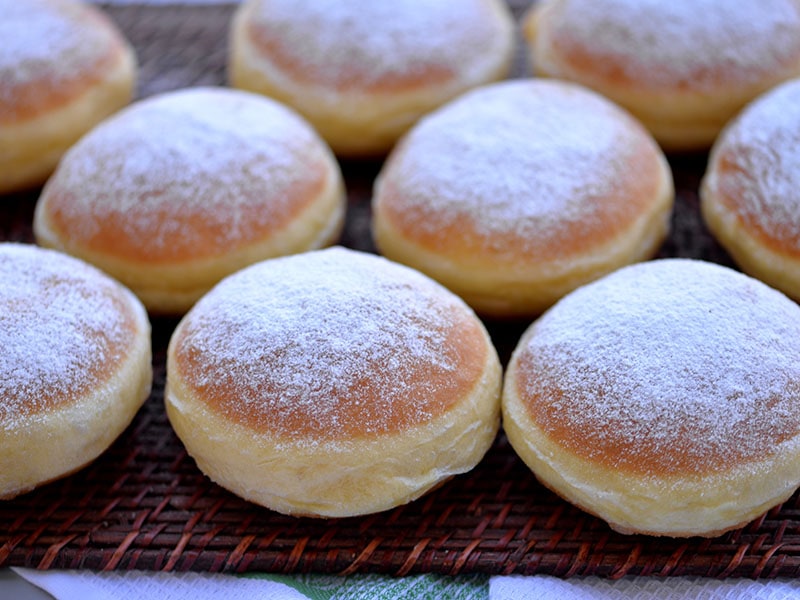
The rich dough includes eggs and some types of fat such as oil, cream, and butter. You can make soft and fluffy bread with this type of dough. The dough can have a smooth and transparent texture if done correctly.
You may find that rich dough is a bit sweeter than other types of dough. However, sugar is not an essential ingredient in this dough mixture. The non-sweet version of rich dough is used widely in making dinner rolls and brioche.
3 Scrumptious Recipes From Different Types Of Dough
You have learned all about different types of basic dough in baking, but how can you apply them? Here are the three most famous recipes using the above dough types. I’m sure that they are all easy to do and the final result will be stunning!
Classic French Éclair
Want a brand new recipe for tonight’s dessert? Try to make Éclair! Traditional chocolate Éclair is a classic dessert dish from France that uses simple choux pastry dough to make the base. It will be super fun to make these delectable sweet treats with your children!
How about making some chocolate Éclair for your kids?
Pistachio Baklava
As I have mentioned, you can always apply the phyllo dough in making Pistachio Baklava. While a festive dish in Middle Eastern cuisine, it will also be a wonderful savory dish to enjoy on an ordinary day. These light yet rich flaky pieces of Baklava will surely make your day!
Ham And Cheese Quiche
For the best ham and cheese quiche, you may want to use the pie dough or kourou dough as a base. This recipe is a combination of delicious ingredients with beautiful colors that will please both of your eyes and taste buds.
Have You Chosen Yourself The Most Suitable Type Of Dough?
I have revealed all of the best types of dough that you can apply to your baked dishes. They are all easy to do and can create the tastiest bread or pastry ever. Don’t be shy to interact with me through the comment section if you’ve got any questions.
Also, if this article is interesting to you, like and share it right now to spread it to your beloved ones! It will be super helpful if some of them want to learn how to bake. Read other articles to get more tips or information about things you are interested in. Hope to see you soon!
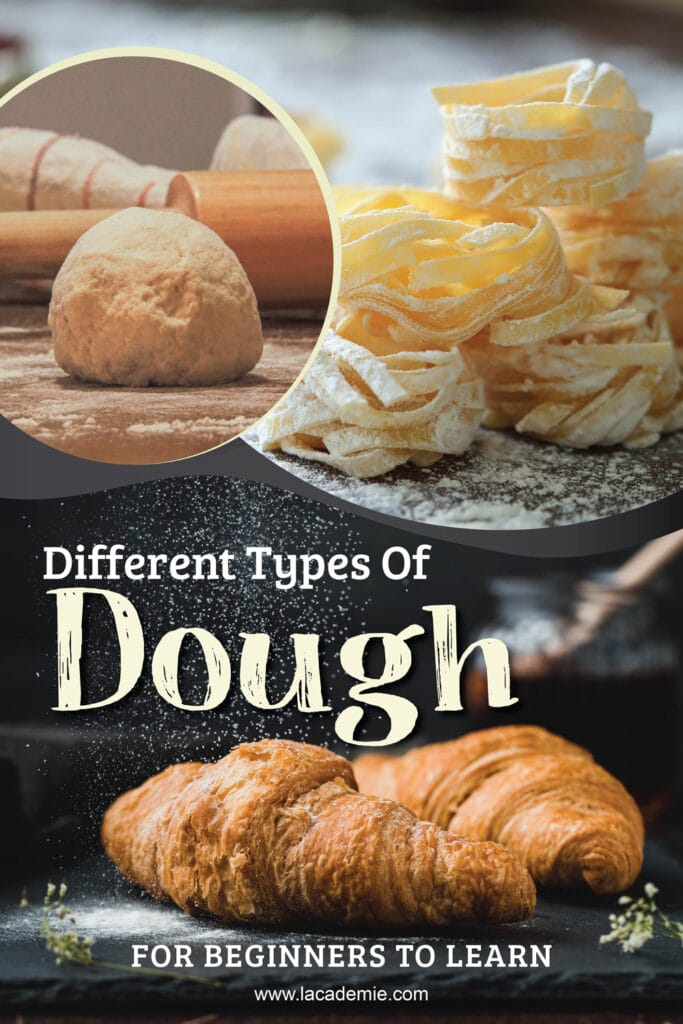


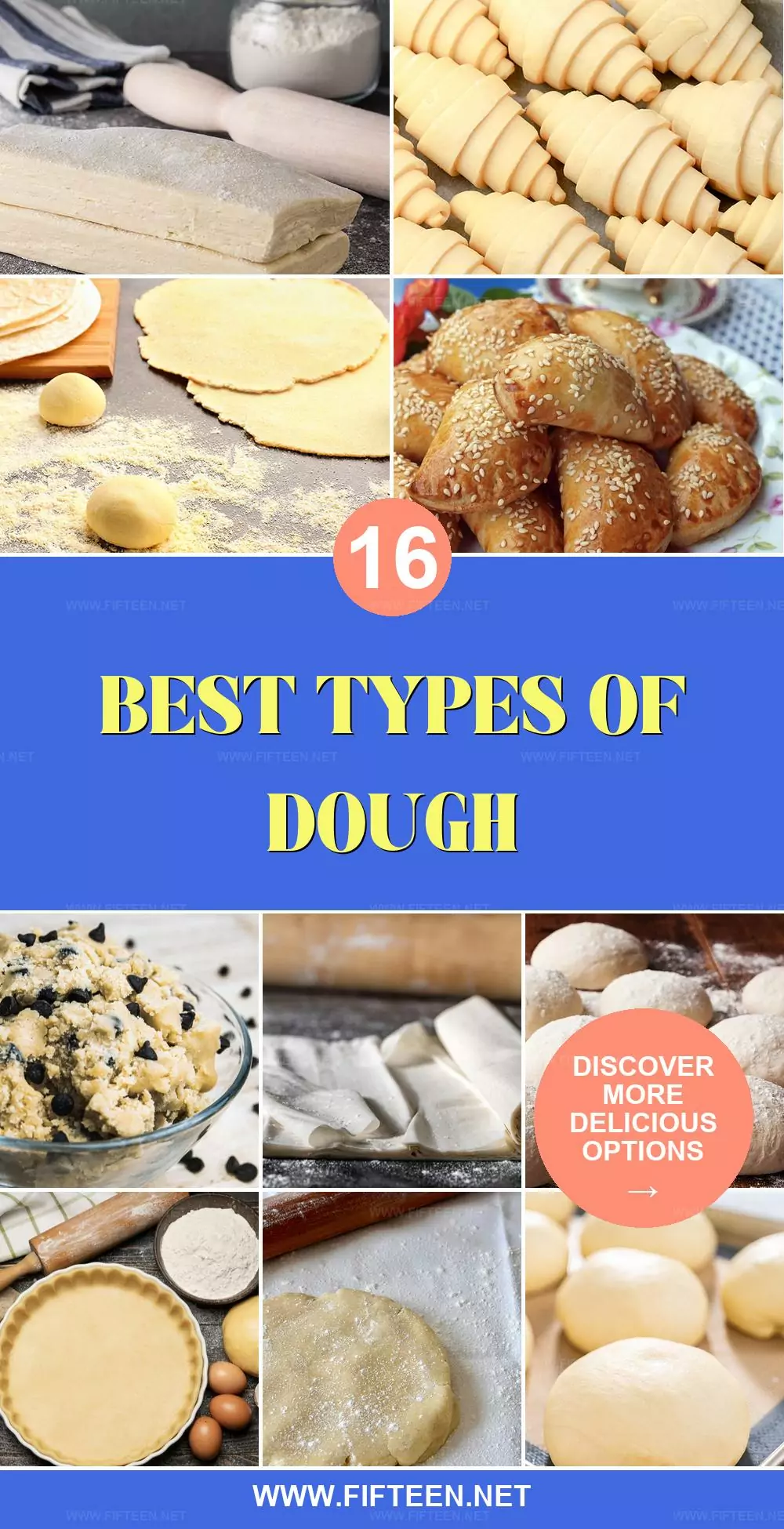
Jamie Scott
Editor in Chief, Senior Content Writer
Expertise
Home Cooking, Meal Planning, Recipe Development, Baking and Pastry, Food Editor, Cooking-video Maker, Western Food Evaluation Expert
Education
Le Cordon Bleu College of Culinary Arts
Local Community College, New York, NY
Jamie Scott is a skilled culinary expert and content creator specializing in Western cuisine. With over 15 years in the culinary field and formal training from Le Cordon Bleu, Paris, Jamie deeply understands how to blend nutrition with delicious flavors. His passion for cooking matches his commitment to making healthy eating accessible and enjoyable.
On Fifteen.net, Jamie brings a fresh perspective to classic dishes and beverages, offering readers insightful recipes, cooking tips, and a fresh view on meal planning that emphasizes taste, health, and simplicity.